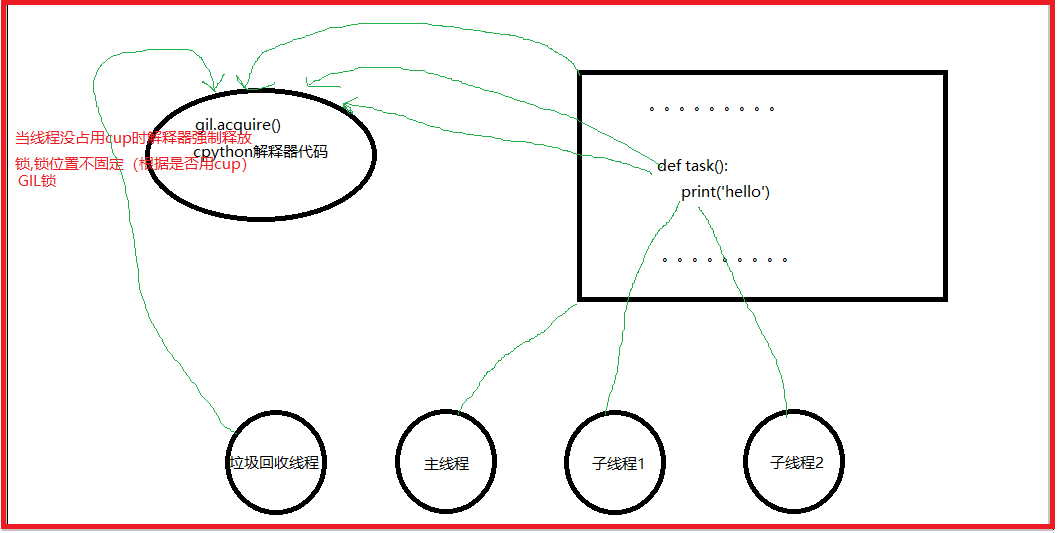一、全局解释器锁 (GIL)
运行test.py的流程:
a、将python解释器的代码从硬盘读入内存
b、将test.py的代码从硬盘读入内存 (一个进程内装有两份代码---一份cpython解释器代码一份test.py代码)
c、将test.py中的代码像 字符串一样 读入python解释器中解析执行
运行test.py的流程:
a、将python解释器的代码从硬盘读入内存
b、将test.py的代码从硬盘读入内存 (一个进程内装有两份代码---一份cpython解释器代码一份test.py代码)
c、将test.py中的代码像 字符串一样 读入python解释器中解析执行
1 、GIL:全局解释器锁 (CPython解释器的特性)
#本质就是一把互斥锁,相当于执行权限,每个进程内都会存在一把GIL
#本质就是一把互斥锁,相当于执行权限,每个进程内都会存在一把GIL
#同一进程的多个线程必须抢到GIL才能使用CPython解释器解释执行自己的代码,
#同一进程的多线程无法实现并行,但可以实现并发
In CPython, the global interpreter lock, or GIL, is a mutex that prevents multiple
native threads from executing Python bytecodes at once. This lock is necessary mainly
because CPython’s memory management (垃圾回收机制线程,由解释器定期执行,不是线程安全)is not thread-safe(如果没有gil 多线程拿到解释器 并行(现在计算机都是多cup),当x=10的线程中内存中产生一个10,还没来的及绑定x,就有可能被垃圾回收机制回收,为了保证数据安全加gil锁).However, since the GIL exists, other features have grown to depend on the guarantees that it enforces.)
GIL本质就是一把加在解释器身上的互斥锁(执行权限)。同一个进程内的所有线程都需要先抢到GIL锁,才能执行解释器代码
In CPython, the global interpreter lock, or GIL, is a mutex that prevents multiple
native threads from executing Python bytecodes at once. This lock is necessary mainly
because CPython’s memory management (垃圾回收机制线程,由解释器定期执行,不是线程安全)is not thread-safe(如果没有gil 多线程拿到解释器 并行(现在计算机都是多cup),当x=10的线程中内存中产生一个10,还没来的及绑定x,就有可能被垃圾回收机制回收,为了保证数据安全加gil锁).However, since the GIL exists, other features have grown to depend on the guarantees that it enforces.)
GIL本质就是一把加在解释器身上的互斥锁(执行权限)。同一个进程内的所有线程都需要先抢到GIL锁,才能执行解释器代码
2、GIL的优缺点:
优点:保证Cpython解释器内存管理的线程安全
缺点:(一个进程内的线程只能一个一个并发执行)在Cpython解释器中,同一个进程下开启的多线程,同一时刻只能有一个线程执行,也就说Cpython解释器的多线程无法实现并行无法利用多核优势
优点:保证Cpython解释器内存管理的线程安全
缺点:(一个进程内的线程只能一个一个并发执行)在Cpython解释器中,同一个进程下开启的多线程,同一时刻只能有一个线程执行,也就说Cpython解释器的多线程无法实现并行无法利用多核优势
注意:
a、GIL不能并行,但有可能并发,不一定为串行。(因为串行是一个任务完完全全执行完毕后才进行下一个;而cpython中,一个线程在io时,被CPU释放时,会被强行取消GIL的使用权限)
b、多核(多CPU)的优势是提升运算效率
c、计算密集型--》使用多进程,用上多核,同时存在(cup数的进程)数并行
a、GIL不能并行,但有可能并发,不一定为串行。(因为串行是一个任务完完全全执行完毕后才进行下一个;而cpython中,一个线程在io时,被CPU释放时,会被强行取消GIL的使用权限)
b、多核(多CPU)的优势是提升运算效率
c、计算密集型--》使用多进程,用上多核,同时存在(cup数的进程)数并行
多进程:创建新进程(拷贝),切换进程---》开销大(时间上,内存上)
d、IO密集型--》使用多线程 并发
多线程:创建新线程,切换线程----》开销小(时间上,内存上)
d、IO密集型--》使用多线程 并发
多线程:创建新线程,切换线程----》开销小(时间上,内存上)

二、Cpython解释器并发效率验证
1、计算密集型应该使用多进程
from multiprocessing import Process
from threading import Thread
1、计算密集型应该使用多进程
from multiprocessing import Process
from threading import Thread
import time
# import os
# print(os.cpu_count()) #查看cpu个数
# import os
# print(os.cpu_count()) #查看cpu个数
def task1():
res=0
for i in range(1,100000000):
res+=i
res=0
for i in range(1,100000000):
res+=i
def task2():
res=0
for i in range(1,100000000):
res+=i
res=0
for i in range(1,100000000):
res+=i
def task3():
res=0
for i in range(1,100000000):
res+=i
res=0
for i in range(1,100000000):
res+=i
def task4():
res=0
for i in range(1,100000000):
res+=i
res=0
for i in range(1,100000000):
res+=i
if __name__ == '__main__':
# p1=Process(target=task1)
# p2=Process(target=task2)
# p3=Process(target=task3)
# p4=Process(target=task4)
# p1=Process(target=task1)
# p2=Process(target=task2)
# p3=Process(target=task3)
# p4=Process(target=task4)
p1=Thread(target=task1)
p2=Thread(target=task2)
p3=Thread(target=task3)
p4=Thread(target=task4)
start_time=time.time()
p1.start()
p2.start()
p3.start()
p4.start()
p1.join()
p2.join()
p3.join()
p4.join()
stop_time=time.time()
print(stop_time - start_time)
p2=Thread(target=task2)
p3=Thread(target=task3)
p4=Thread(target=task4)
start_time=time.time()
p1.start()
p2.start()
p3.start()
p4.start()
p1.join()
p2.join()
p3.join()
p4.join()
stop_time=time.time()
print(stop_time - start_time)
2、IO密集型应该使用多线程
from multiprocessing import Process
from threading import Thread
from multiprocessing import Process
from threading import Thread
import time
def task1():
time.sleep(3)
time.sleep(3)
def task2():
time.sleep(3)
time.sleep(3)
def task3():
time.sleep(3)
time.sleep(3)
def task4():
time.sleep(3)
time.sleep(3)
if __name__ == '__main__':
# p1=Process(target=task1)
# p2=Process(target=task2)
# p3=Process(target=task3)
# p4=Process(target=task4)
# p1=Process(target=task1)
# p2=Process(target=task2)
# p3=Process(target=task3)
# p4=Process(target=task4)
# p1=Thread(target=task1)
# p2=Thread(target=task2)
# p3=Thread(target=task3)
# p4=Thread(target=task4)
# start_time=time.time()
# p1.start()
# p2.start()
# p3.start()
# p4.start()
# p1.join()
# p2.join()
# p3.join()
# p4.join()
# stop_time=time.time()
# print(stop_time - start_time) #3.138049364089966
# p2=Thread(target=task2)
# p3=Thread(target=task3)
# p4=Thread(target=task4)
# start_time=time.time()
# p1.start()
# p2.start()
# p3.start()
# p4.start()
# p1.join()
# p2.join()
# p3.join()
# p4.join()
# stop_time=time.time()
# print(stop_time - start_time) #3.138049364089966
p_l=[]
start_time=time.time()
start_time=time.time()
for i in range(500):
p=Thread(target=task1)
p_l.append(p)
p.start()
p=Thread(target=task1)
p_l.append(p)
p.start()
for p in p_l:
p.join()
p.join()
print(time.time() - start_time)
三、线程互斥锁与GIL对比
cpython中
GIL能保护解释器级别代码(和垃圾回收机制有关)但保护不了其他共享数据(比如自己的代码)。所以在程序中对于需要保护的数据要自行加锁
gil只是保证一个进程内的所有线程都是并发(不是串行吗)执行,[一个线程在io时,被CPU释放时,会被强行取消GIL的使用权限]
cpython中
GIL能保护解释器级别代码(和垃圾回收机制有关)但保护不了其他共享数据(比如自己的代码)。所以在程序中对于需要保护的数据要自行加锁
gil只是保证一个进程内的所有线程都是并发(不是串行吗)执行,[一个线程在io时,被CPU释放时,会被强行取消GIL的使用权限]
主线程,线程1,线程2,垃圾回收线程》》》》》》》》》》》》》》》》》》》》》》》》》》》》》》》》》》》》》》》》》
线程1抢到gil 当拿到cpu 解释执行代码:抢到互斥锁 睡 (切—剥夺cpu-强行释放gil锁)改数据 放开互斥锁
线程2抢到gil 当拿到cpu 解释执行代码:发现互斥锁还没释放等(切-剥夺cpu,强行释放gil)
线程3。。。
线程2。。。。
垃圾线程抢到gil,当拿到cpu 解释执行代码:回收引用计数为0的数据.....
线程1抢到gil,当拿到cpu 解释执行代码:改数据 放开互斥锁
线程2抢到gil 当拿到cpu 解释执行代码:发现互斥锁还没释放等(切-剥夺cpu,强行释放gil)
线程3。。。
线程2。。。。
垃圾线程抢到gil,当拿到cpu 解释执行代码:回收引用计数为0的数据.....
线程1抢到gil,当拿到cpu 解释执行代码:改数据 放开互斥锁
。。。。。。。。。。。。。。
from threading import Thread,Lock
import time
import time
mutex=Lock()
count=0
count=0
def task():
global count
mutex.acquire()
temp=count
time.sleep(0.1)
count=temp+1
mutex.release()
global count
mutex.acquire()
temp=count
time.sleep(0.1)
count=temp+1
mutex.release()
if __name__ == '__main__':
t_l=[]
for i in range(2):
t=Thread(target=task)
t_l.append(t)
t.start()
for t in t_l:
t.join()
t_l=[]
for i in range(2):
t=Thread(target=task)
t_l.append(t)
t.start()
for t in t_l:
t.join()
print('主',count)